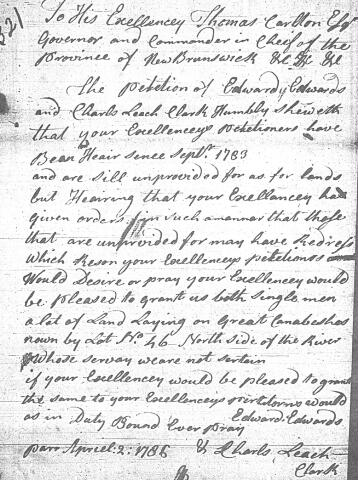Ruby M. Cusack

|
| A copy of the Land Petition of Edward Edwards and Charles Leach Clark,
both single men and dated April 2, 1786. It states they have been residents
since September of 1783 and still hadn't received land.
Courtesy of Kathy Cormier
|
Every day during the summer, Cliff and I played for hours in the brook. As the bright sun shone this early August morning, we walked in our bare feet, along the wet muddy edge looking for telltale signs of what had happened while we slept. I was excited to see that a mother racoon and her little ones had been there the night before. From the numerous little foot prints, those babies must have played for quite some time. Next we spotted the deep sharp imprints of the hooves of a deer who had crossed the brook. From the size of the tracks it must have been a large buck. We wandered down to the beaver dam and saw poplar trees that had been freshly cut and dragged to the water by the beavers.
Now that I think about it, these animals left their mark for us to learn about them, much like the settlers who petitioned for land left information for us to find.
The first step in getting land from the government was the petition to the Lieutenant Governor.
For the early settler, the petition usually described himself, his need, his family, any service rendered to the Crown, length of residence in the province and the parcel of land he desired.
The Lieutenant-Governor-in-Council, acting as a Committee of Council
on Land, would either approve or deny the petition. The reasons for denial
sometimes provide as much information to the researcher as if the grant were
approved. It can also put your ancestor in an area where you least expect
as quite often he was actually a squatter on the land and it would be necessary
for him to make another petition.
The personal description in the petition can be very informative. A woman
may state she had been abandoned by her spouse and left with a number of
children. A widow may base her petition on her father participating in the
Revolutionary War, thus proving loyalist lineage. One gentleman stated he
had to have his toes amputated due to frost bite. Others may state they desire
the land that borders a relative.
If the petition was approved, an Order or Warrant of Survey was issued to the deputy-surveyor who established the boundaries of the grant to be issued.
If you check the Crown Land Grant Index and find that your ancestor received a land grant, don't stop there. Go to the petitions and review this information as maybe he or other members of his family made other applications. Even if no land was granted there could be an interesting land petition.
Many land grants were considered to be a reward for remaining loyal to the crown. To some immigrants it was the desire to own land that was the driving force to cause them to uproot their family and journey to this province. The land petitions, they left behind are often our reward for searching and the driving force that keeps us rooting for more answers.
* * *
Query 98-706
Forsythe: I am working on a Forsythe Family History. I need information
on my grandfather John Forsythe who was born in Saint John on Nov. 10, 1846.
At the age of 15 he moved to Boston, then to Chicago, Illinois in 1866, and
on to Milwaukee, Wisconsin. He came to Minnesota in 1869 and purchased his
farm in Frankfort Township, Wright County and lived there until his death
on Sep. 20, 1923. His mother's name was Margaret and he may have had a brother
George. Any information will be greatly appreciated.
-Muriel (Forsythe) Zumbusch, 610 Division Street E., Buffalo, Minnesota,
55313. elephone 612-682-2493 or E-mail to nelson_james@email.msn.com.
Query 98-707
Donners: I am seeking any information available on William and Salome
Donner and their descendants; Elizabeth, Mrs. John Hickey; Harriet Meehan
Norrid; Clara, Mrs. Avard Clark; Margaret, Mrs. Edward Tucker, later Mrs.
Levan (Pat) Ross; Emma Jane Dibble; James Samuel (Dorothy Maud Campbell);
George William (Alice Mary Clarke) and later married (Clara M. Nixon); Harry
Silence (Annie J. Crockett); Susanna, Mrs. Otis Cogswell; Elizabeth (Bessie),
Mrs. Clifford Bent; Eva, Mrs. William Boyne; Benjamin, not sure of his wife's
name; Lillian, Mrs. Gordon Bent. Lillian was my grandmother. In particular,
I am looking for photographs or papers that may exist. Anything that you
may have, however seemingly insignificant, would be of interest and greatly
appreciated.
-L. Jill Justason, 235 Route 778, Pennfield, N.B., E5H 2B8. Telephone
(506) 456-2959. E-mail to jill@nbnet.nb.ca.
Query 98-708
Canavan: I'm searching for any information on the Canavans of Johnville,
more particularly their "migration patterns" out of the area. My great-grandfather,
William Henry Canavan (born 1876) was orphaned in Chicago as a toddler and
I have some reason to believe that his father (possible first names are William
Henry, John, or Peter) might have Canadian connections. William's father
may have emigrated to Toronto as he was said to be a Great Lakes ship captain
and eventually on to Chicago before dying in a shipwreck on the Lakes. Any
Canavan info would be most appreciated.
-Lillie R. Canavan,110 Lake St., Deerfield, WI, 53531. E-mail
to Lillie@compuserve.com.
Ruby is a genealogy buff. Readers are invited
to send their New Brunswick genealogical queries to her at rmcusack@nbnet.nb.ca.
When E-Mailing please put Yesteryear Families
in the Subject line. Please include in the query, your name and postal
address as someone reading the newspaper, may have information to share
with you but not have access to E-mail. Queries should be no more than
45 words in length.